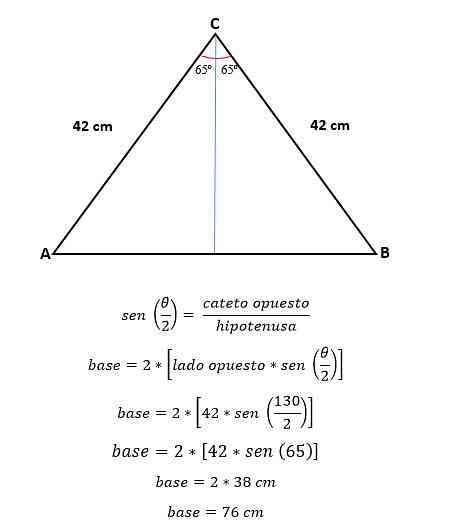
If the known angle is opposite a marked side, then the angle opposite the other marked side is the same.If only one angle is known in an isosceles triangle, then we can find the other two missing angles using the following steps:
ISOSCELES TRIANGLE FORMULA HOW TO
How to Find Missing Angles in an Isosceles Triangle from only One Angle We can also think, “What angle do we need to add to 70° and 70° to make 180°?” The missing angle on the top of this isosceles triangle is 40°. We subtract the 140° from 180° to see what the size of the remaining angle is. The missing angle is not opposite the two marked sides and so, we add the two base angles together and then subtract this result from 180 to get our answer.Īngles in an isosceles triangle add to 180°. The two base angles are opposite the marked lines and so, they are equal to each other. This is because all three angles in an isosceles triangle must add to 180°įor example, in the isosceles triangle below, we need to find the missing angle at the top of the triangle. If the missing angle is not opposite a marked side, then add the two angles opposite the marked sides together and subtract this result from 180.If the missing angle is opposite a marked side, then the missing angle is the same as the angle that is opposite the other marked side.To find a missing angle in an isosceles triangle use the following steps: How to Find a Missing Angle in an Isosceles Triangle If we are told that one of these marked angles is 70°, then the other marked angle must also be 70°.

The angle at which these two marked sides meet is the odd one out and therefore is different to the other two angles. The two equal angles are opposite to the two equal sides. The sides that are the same length are each marked with a short line. We can see that in this above isosceles triangle, the two base angles are the same size.Īll isosceles triangles have a line of symmetry in between their two equal sides. It has two equal sides marked with a small blue line. We can recognise an isosceles triangle because it will have two sides marked with lines.īelow is an example of an isosceles triangle. The two equal sides are marked with lines and the two equal angles are opposite these sides. See more information about triangles or more details on solving triangles.An isosceles triangle is a triangle that has two equal sides and two equal angles. Look also at our friend's collection of math problems and questions: What can be the area of a right isosceles triangle with a side length of 8 cm?

The base is 2 cm longer than the shoulder. The perimeter of the isosceles triangle is 32 cm. What is the length of the cathetus of an isosceles right triangle with an 8 cm long? Calculation and procedure.Ĭompute the base of an isosceles triangle, with the arm a=20 cm and a height above the base h=10 cm.

The profile of the railway embankment has the shape of an isosceles trapezoid, where a = 16.4 m, c = 10.6 m, and b = d = 5.2 m. How many isosceles triangles form in a square when we mark all diagonals in it? What are the angles of an isosceles triangle ABC if its base is long a=5 m and has an arm b=4 m? The given is an isosceles triangle with a base of 24dm and an arm of 15dm. Calculate the height of the triangle.įind the length (circumference) of an isosceles trapezoid in which the length of the bases a,c, and the height h are given: a = 8 cm c = 2 cm h = 4 cm. How long is a third side?Ĭalculate the area of an isosceles triangle, the base of which measures 16 cm and the arms 10 cm.Īn isosceles triangle with a base of 8 cm. Calculate the radius of the inscribed (r) and described (R) circle.Ĭonstruct an isosceles triangle if a given circle circumscribed with a radius r = 2.6 cm is given.Īn isosceles triangle has two sides of length 7 km and 39 km. In an isosceles triangle ABC is |AC| = |BC| = 13 and |AB| = 10. It is not a problem to calculate an isosceles triangle, for example, from its area and perimeter ( T=12 p=16).Įxamples of calculating isosceles triangles:Īn isosceles triangle in word problems in mathematics:Ĭalculate the perimeter of the isosceles triangle with arm length 73 cm and base length of 48 cm. Our calculator provides the calculation of all parameters of the isosceles triangle if you enter two of its parameters, e.g. An isosceles triangle is a triangle that has two sides of equal length. This calculator calculates any isosceles triangle specified by two of its properties.


 0 kommentar(er)
0 kommentar(er)
